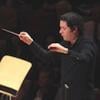
John Adams, 72, returns later this month to the San Francisco Symphony and to Davies Hall, the edifice he helped the ensemble inaugurate in 1980. At that time, the commission offered the young composer and San Francisco Conservatory of Music professor by SFS conductor Edo de Waart “blew me away,” Adams recalls. As his prolific career and his commissions grew, Adams maintained his relationship with the Symphony, which premiered several of his works and tapped him to pilot a vital New and Unusual Music series. Adams’s I Still Dance will debut at Davies Sept. 19–22, as a tribute to outgoing Symphony conductor Michael Tilson Thomas and his husband, Joshua Robison, who himself has served both Thomas and the ensemble in a professional capacity. Adams’s musical relationship with MTT long predates their Davies collaborations, as well as the composer’s parallel achievements in opera. SFCV spoke with Adams from his primary residence, in Berkeley, after his drive home from the sylvan Sonoma County property he shares with his wife, fine art photographer and videographer Deborah O’Grady.
I assume that was rather a longish ride for you, and that your ‘machine’ may have not been so fast.
After a minute or two, you end up behind a Winnebago, and go from 50 down to 20, but the only thing I can say is, if you could have seen the view I was looking at while I was going in and out of [cell phone] reception, you would have loved it. It was so beautiful, coming down the coast road.

What were you doing up there?
We have a house that we built about ten years ago, in the backwoods, and it’s just now that the fire season has started, and we had a two-hour briefing with the local fire department. It was pretty sobering.
But were you also doing your work?
Oh, yeah. I have what I call my “Mahler hut,” a little hut about a quarter of a mile away from the house, and it’s in even deeper woods. I have electricity, but no plumbing.
Any new stuff to share with readers?
I have several projects I’ve been working on. I spent quite a bit of time last winter revising the first act of [his 2017 opera] Girls of the Golden West, which has now been done [in February of this year] in Amsterdam, and I’m very satisfied with that.
What had to be done to it?

A lot of people felt that the dynamics amongst the characters didn’t really start to come into focus until the second act, and I took that to heart. I changed the last scene [of the first act] radically, so that there’s more depth to the character of Ned, the former slave, and to his intimacy with Dame Shirley. And I added a really hair-raising ending . . . where they’re trying to get the miners to go out and kill some Indian squaws and children, because one of their guys has been killed by an Indian. But I have to say, in my collaborator’s [Peter Sellars] defense, that people judge operas so severely and I know how hard somebody like Peter works: most of that work is done in a small room, and you get a shockingly small amount of time [rehearsing] on the big stage. Things that are deeply moving and subtle, when you get out into the yawning chasm of the opera house, in some cases, they just don’t work. It happens musically, too. I remember with Nixon in China: everybody wants to say what a classic that is now, but I remember what a mess it was in Houston [at its debut with Grand Opera, in 1987]. And how it really didn’t come into focus for four years. People forget that opera is an incredibly complex vehicle.
Getting to the premiere of I Still Dance, the Boosey & Hawkes press release says it celebrates the relationship of MTT to his husband.
I think I told them I was always impressed by their youthfulness. I had written a piece two years ago [I Still Play] for another longtime friend, Robert Hurwitz, who was the president of Nonesuch. But I don’t want to make a big deal out of the titles or to attempt to give any more adjectives.
In discussing your history with MTT, they credit him with the inception of Short Ride in a Fast Machine in 1986.
I would say it was more like his request. He’d asked me to write a fanfare for the opening of a music festival [the Great Woods Festival, of which MTT was the music director, for the Pittsburgh Symphony Orchestra]. It was a chaotic premiere, largely because the auditorium wasn’t finished on the day of the opening, and right before the concert, there was a rainstorm. I didn’t think I had a winner, but there’s a performance of that work somewhere in the world several times a week.
And MTT has continued to promote your work.
He’s done it periodically. There are several pieces he’s done exceptionally well, like Harmonielehre, which he made a really good recording of [with the SFS, for SFS Media in 2012]. And Absolute Jest, which he really took to heart [with the SFS and the St. Lawrence String Quartet, for SFS Media in 2015].
Boosey & Hawkes also points out the enhanced instrumentation of I Still Dance, with djembe, taiko, and electric bass.
Believe it or not, I used them all in that oratorio I wrote a couple of years ago, The Gospel According to the Other Mary. And I used the bass guitar — in a quiet way — in the piano concerto I wrote for the LA Phil and Yuja Wang [Must the Devil Have All the Good Tunes? 2019]. I think the bass guitar should be a regular part of the modern orchestra. We think of it as a rock ’n’ roll instrument but when it’s played by a really skillful player, with good equipment, it blends beautifully, and gives a wonderful low resonance that I very much like. It can always cause some kind of problem, because the orchestra may have to look outside its regular personnel. But in this case, the principal bass [for the SFS], Scott Pingel, plays the instrument well.
In our interview with Scott, we found out he’s a jazz fan, too.
So he and I have been having very useful back-and-forth about what I wrote, and there have been several rounds of revisions, to make it more negotiable. I was just in touch with Simon Rattle, because he’s been touring with an older piece of mine, Harmonielehre, with the London Symphony, and he was just saying how grateful the percussion players are, because it gives them something to do. [laughs]
I assume you’ll stay connected with San Francisco under Esa-Pekka Salonen.
He’s got his “brain trust,” and he’ll be working through that for the first couple of years. But we’re good friends, and I hope he’ll do some of my pieces. I wrote a big, 50-minute symphony [Naive and Sentimental Music] for him back in 1999, and he did it two years ago at the Proms [with the Philharmonia Orchestra]. And I’m hoping he’ll do that here.
Will Girls of the Golden West get a recording?
I’ve got the right cast and a great orchestra, and I know it’ll be really good, but that won’t happen for a couple of years. I’m glad we waited all the time we did [from the 2005 debut to the 2018 Nonesuch release] before we recorded Doctor Atomic. That’s the way things happen in the opera world.
I understand the LA Philharmonic is touring with Must the Devil Have All the Good Tunes? But you’re not?
I decided I should probably stay home. I’ve been home all summer, working on my composing, and now I have a lot of conducting, weeks with the Philadelphia and the New York Philharmonic and Seattle and St. Louis and then a bunch of European orchestras. I have to come out of my cocoon and start being somebody who can stand in front of an orchestra and run a rehearsal. I have to sort of get into extrovert mode. [chuckles] I always have this one type of archetypal dream, and I had it again a couple of nights ago: I miss my plane. It’s always that dream that announces to me, time’s up!
Will you be with us here for your latest Davies premiere?
Yes, of course!
Note: MTT will conduct the SFS in performances of I Still Dance next March at Carnegie Hall and the Royal Festival Hall.
Correction: Adams’s new work, I Still Dance, was incorrectly referred to as I Keep Dancing in the first paragraph of the article as originally published.





